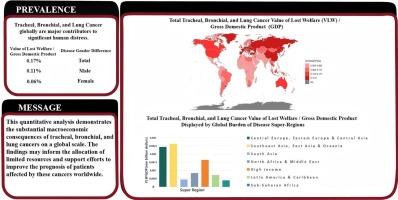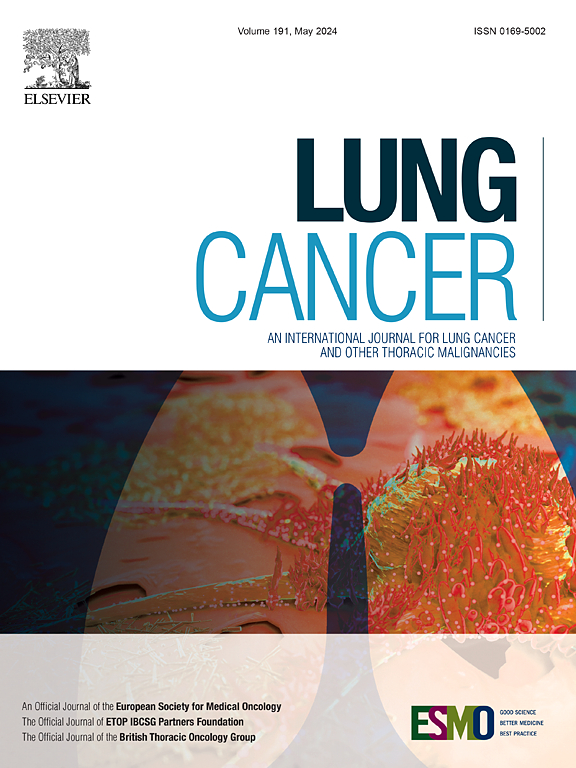气管、支气管和肺癌的全球、区域和国家经济后果
IF 4.4
2区 医学
Q1 ONCOLOGY
引用次数: 0
摘要
考虑到全球发病率上升、人口老龄化以及中低收入国家(LMICs)的限制,量化气管、支气管和肺癌(肺癌)的宏观经济影响对于指导资源配置至关重要。本研究评估了2021年肺癌的全球、区域和国家宏观经济负担。方法残疾调整生命年(DALYs)数据来自全球疾病负担(GBD) 2021研究。经购买力平价(PPP)调整后的国内生产总值(GDP)数据来自世界银行。采用福利损失价值(VLW)方法估算宏观经济负担,将DALYs与从美国数据推断的统计寿命价值(VSL)结合起来,假设收入弹性(IE)为1.0。结果以2021年国际美元(USD)计算,经购买力平价调整。结果在全球范围内,肺癌造成的VLW为1673.6亿美元(占全球GDP的0.17%)。男性的负担(1078.5亿美元,GDP的0.11%)高于女性(595.2亿美元,GDP的0.06%)。VLW/GDP比例最高的地区是东南亚、东亚和大洋洲(548.2亿美元,占该地区GDP的2.62%)。烟草是主要风险因素,占全球VLW的1052亿美元(63%),其次是空气污染(229亿美元)和职业风险(276亿美元)。这一定量分析表明,肺癌对全球宏观经济造成了重大负担,在性别(对男性的影响尤为严重)和地理区域之间存在显著差异。这些发现强调必须优先考虑基于证据的干预措施,特别是在高负担地区的烟草控制,以优化资源分配并改善全球患者预后。主要限制包括依赖基于模型的VSL估计(从美国数据推断)和恒定收入弹性假设(IE = 1.0);普遍化可能受到各国在支付意愿和数据可得性方面的差异的限制,特别是在中低收入国家。本文章由计算机程序翻译,如有差异,请以英文原文为准。

Global, regional, and national economic consequences of tracheal, bronchial, and lung cancer
Background
Quantifying the macroeconomic impact of tracheal, bronchial, and lung cancers (lung cancer) is crucial for guiding resource allocation, given rising global incidence, aging populations, and constraints in low- and middle-income countries (LMICs). This study evaluated the global, regional, and national macroeconomic burden of lung cancer in 2021.
Methods
Disability-adjusted life years (DALYs) data came from the Global Burden of Disease (GBD) 2021 study. Gross Domestic Product (GDP) data, adjusted for Purchasing Power Parity (PPP), were sourced from the World Bank. The macroeconomic burden was estimated using the Value of Lost Welfare (VLW) approach, integrating DALYs with the Value of Statistical Life (VSL) extrapolated from US data, assuming income elasticity (IE) of 1.0. Results are in 2021 international dollars (USD), PPP-adjusted.
Results
Globally, lung cancer caused a VLW of United States Dollars (USD) 167.36 billion (0.17% of global GDP). Males bore a higher burden (USD 107.85 billion, 0.11% GDP) than females (USD 59.52 billion, 0.06% GDP). The VLW/GDP ratio was highest in Southeast Asia, East Asia, and Oceania (USD 54.82 billion, 2.62% regional GDP). Tobacco was the leading risk factor, contributing 105.2 billion USD (63%) of global VLW, followed by air pollution (22.9 billion) and occupational risks (27.6 billion).
Conclusion
This quantitative analysis demonstrates that lung cancers impose a significant global macroeconomic burden, with pronounced disparities across sexes (disproportionately affecting males) and geographic regions. These findings underscore the imperative to prioritize evidence-based interventions—particularly tobacco control in high-burden areas—to optimize resource allocation and improve patient prognosis worldwide.Key limitations include reliance on model-based VSL estimates (extrapolated from U.S. data) and the assumption of constant income elasticity (IE = 1.0); generalizability may be constrained by cross-country variations in willingness-to-pay and data availability, particularly in LMICs.
求助全文
通过发布文献求助,成功后即可免费获取论文全文。
去求助
来源期刊

Lung Cancer
医学-呼吸系统
CiteScore
9.40
自引率
3.80%
发文量
407
审稿时长
25 days
期刊介绍:
Lung Cancer is an international publication covering the clinical, translational and basic science of malignancies of the lung and chest region.Original research articles, early reports, review articles, editorials and correspondence covering the prevention, epidemiology and etiology, basic biology, pathology, clinical assessment, surgery, chemotherapy, radiotherapy, combined treatment modalities, other treatment modalities and outcomes of lung cancer are welcome.
 求助内容:
求助内容: 应助结果提醒方式:
应助结果提醒方式:


